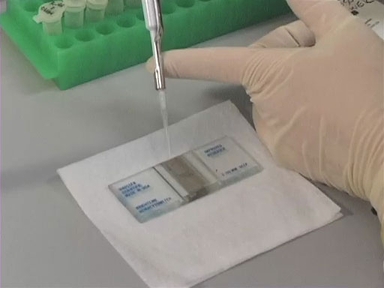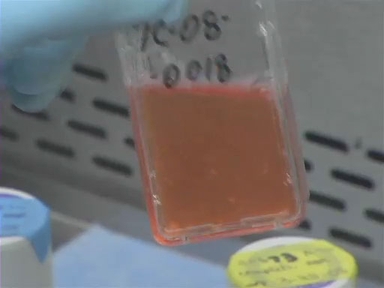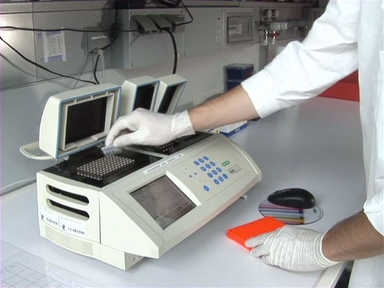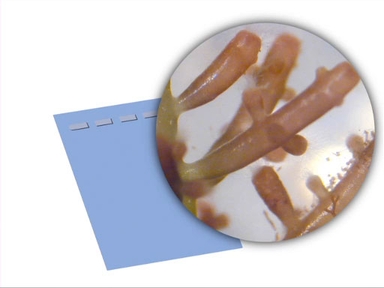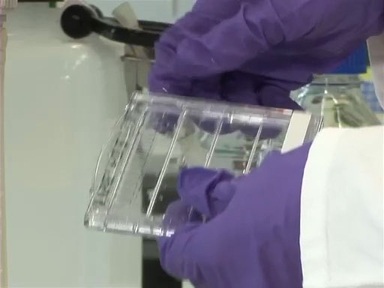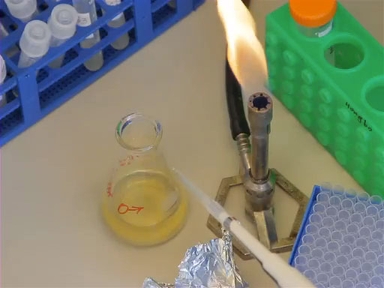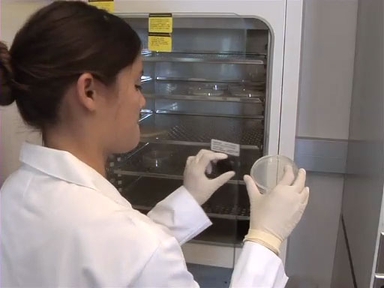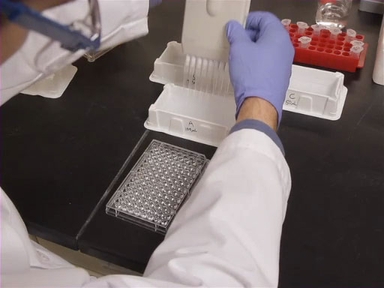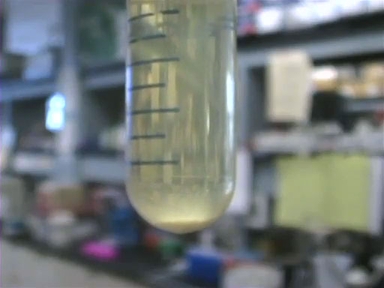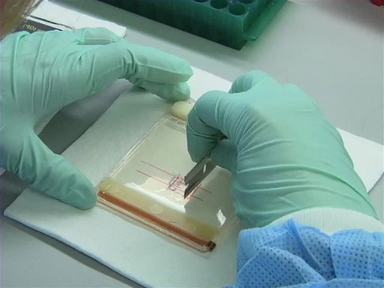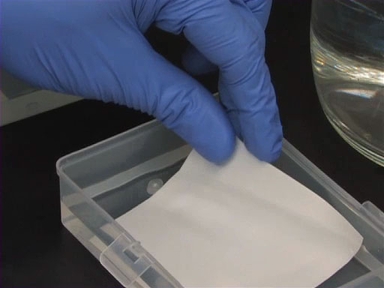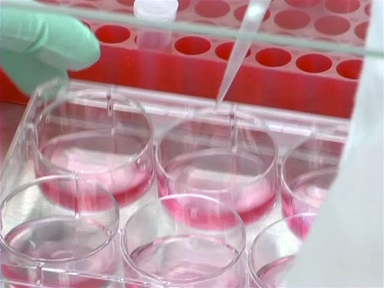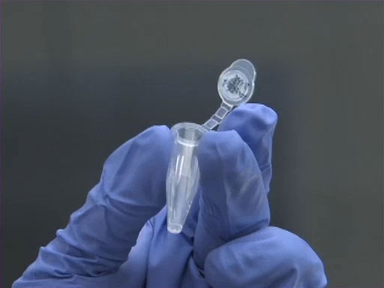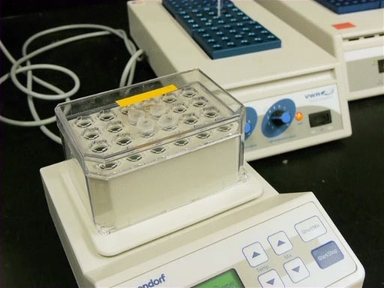Cell counting is an important step in many cell-based assays for determining cell number and viability. In general, the goal of counting is to understand how much a sample of an unknown cell concentration should be diluted for further use. The most common laboratory tool for counting cells is the hemacytometer.
The hemacytometer is a counting tool that was originally created for counting blood cells. At the center of the hemacytometer are two counting chambers, upon which a laser etched grid can be found.
The grid is made up of 9 major quadrants. The four corner quadrants are further divided into 16 smaller quadrants. The central quadrant is divided into 25 of these smaller quadrants, each of which is yet further divided into 16 micro-quadrants.
At the far end of each chamber are sample introduction ports, into which the cell sample to be counted is dispensed.
On either side of the counting chambers are the cover slip mounting supports, upon which the quartz coverslip rests, usually about 0.1 mm above the counting chamber.
Since the area of each large square is 1 mm2, the volume contained by each large square is 0.1 mm3 or 1/10,000th of a ml.
Before counting, always take a moment to use ethanol and a kimwipe to clean and dry away any lint, fingerprints, or watermarks from the coverslip and the counting chamber.
Then carefully add a small amount of water to each of the coverslip mounting supports, the surface tension of the water will hold the coverslip in place.
Now gently triturate the cell suspension, or pipette it up and down, to dislodge any cell clumps. Use a micropipette to aspirate about 10 μl of the suspension and then load one of the introduction ports with the sample. The solution will be drawn into the counting chamber by capillary action and should cover the entire grid.
While the cells are settling, select the objective. Then load the hemacytometer onto the stage.
Next view the cells under the microscope. If there are fewer than 5 cells in each of the large quadrants, you may need to spin your sample down again and resuspend the pellet in a smaller volume. If the cells are overlapping each other or are simply too dense to easily distinguish from one another, you may need to dilute your sample in a higher volume of solution. Be sure to keep track of the factor with which you are diluting your cells. You will need it in a later calculation.
Now it’s time to count the cells!
As we talked about earlier, the counting chamber is covered in a laser-etched grid. The lines of the quadrants make it easier to keep track of the cells you are counting. Choose the size quadrant for counting depending on the density of the cells in your sample. For example, if there are a low number of cells, count all the cells in one of the corner quadrants. For samples with a medium amount of cells, choose one of the 16 smaller quadrants. If there is a very high density of cells, count the cells in one of the 25 central quadrants. No matter which quadrant you choose or the density of the cell sample, count at least 20-50 cells per quandrant.
Not all of the cells will fall neatly within the quadrants. You can count the cells that touch the top and left lines, but disregard the ones touching the bottom or right ones. To get the most accurate count, use a cell counter to keep track of the cells and take the average of the number of cells in 4 quadrants of the same size.
To calculate the number of cells in a 1 ml volume, multiply the number of cells counted by 10,000, because, as we mentioned before, each large square on the grid is 1/10,000th of a ml. If you counted one of these larger quadrants, simply multiply this number 1. If you counted one of the smaller squares in one of the corner quadrants, multiply this number by 16. If you counted all of the cells in one of the 25 central quadrants, multiply this number by 25. If you happened to dilute your cell suspension before loading the hemacyotmeter, you will also need to multiply by the dilution factor.
Then, to calculate the number of cells in 1 ml of this sample, we would multiply the 20 cells in this central quadrant by 104 and 25 to get a total of 5 x 106 cells in 1 ml of the sample.
Now that we know the total number of cells in 1 ml of the sample, we need to multiply this number by the total volume of our solution. So for example, if we have 5 x 106 cells in 1 ml, then in 2 ml, we will have a total of 1 x 107 cells.
Then, to avoid errors from miscounting, uneven distribution of cells, or pipetting errors, load the other side of the chamber and count your cell sample a second time.
Counting the cells under the microscope is also a great time to evaluate the viability of the cells in your sample. Trypan blue, a vital stain, is often mixed with the sample prior to being loaded into the hemacytometer for this purpose.
Live cells exclude this dye, because living cells are very selective about what they allow through their membranes. A dead cell, however, does not have an intact membrane, which allows the trypan blue to pass through and stain the cytoplasm.
To check the viability of your cell sample, dilute an aliquot of your cell suspension in trypan blue, and then load the trypan blue stained sample just like the regular cell sample. Under the phase contrast, the live cells will appear bright and golden and should be counted; do not count any of the dull, dead, blue cells.
Calculate the number of cells as before, this time multiplying the final number by the trypan blue dilution factor. So if our original representative sample had first been diluted in trypan blue, we then would have multiplied our total number of cells by our 1:10 trypan blue dilution, for a total of 1x108 cells in our sample.
When you’re finished counting, remember to clean the coverslip and counting chamber!
Now that you are a cell counting pro, let’s talk about some of the reasons you might need to know how many cells you have in a particular experiment.
After isolating cells from a normal or experimental tissue, it’s important to know how many cells you’ve recovered. Here the investigators will want to know how many splenocytes, or spleen cells, they have isolated from this mouse spleen.
When you are performing an experiment to see how two different cell populations react, it’s important to know how many of each cell type you are mixing together, like in this co-culture experiment with B and T cells.
You will want to know how many cells you have for many other types of cell-based assays. Here an ELISPOT assay is being set up to determine the number of cells in a sample that will secrete IFNγ, an inflammatory protein, in response to the human papilloma virus.
When performing an experiment in which mRNA needs to be extracted, or isolated, from your cells of interest, it’s important to know how many calls you’re starting with, in order to acquire a sufficient amount of mRNA for the experiment.
The hemacytometer is an inexpensive and relatively easy to use tool for counting cells, but it can be tedious and has the potential for human error.
The Scepter Handheld Automatic Counter is, as the name implies, a hand held counting device that has an improved counting accuracy compared to the hemacytometer and that can discriminate both the size and volume of the cells in a cell sample.
The TC10 automated cell counter evaluates both cell number and viability, automatically calculates the total cell number in your sample, and allows the cells to be viewed on its readout screen as well.
You’ve just watched JoVE’s introduction to cell counting. In this video we reviewed: what a hemacytometer is, how to count cells and determine cell viability, and some different reasons you may need to count cells. Thanks for watching and remember not to count the blue cells!
